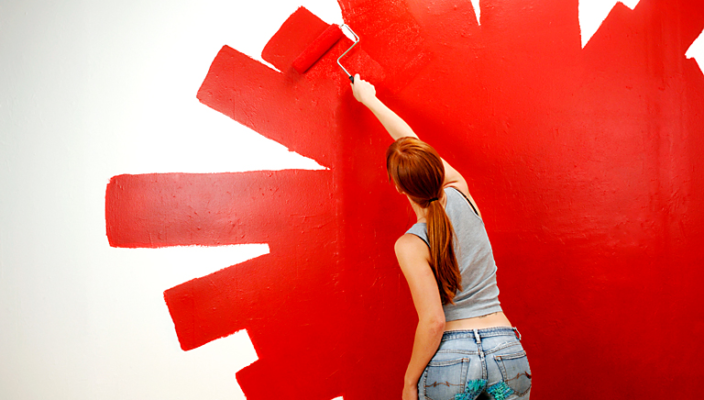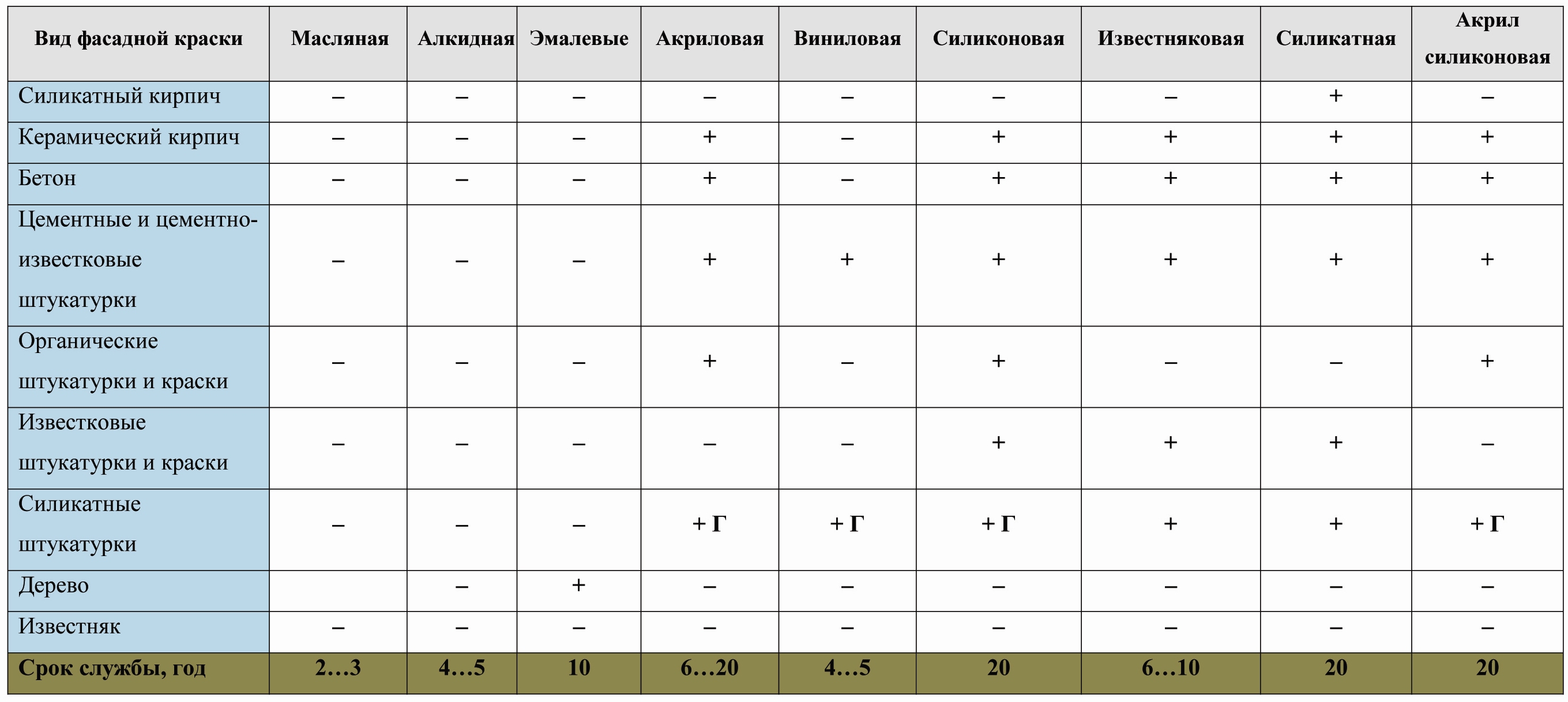Despite the diversity of finishing materials, in the design of the interior, painting is still often used. This is justified if the ideas of painting walls are implemented with their own hands in accordance with the rules and instructions of manufacturers. It is important to choose the material correctly, depending on the functional purpose of the premises. About how to do this and how to apply in practice the main techniques of painting walls will be discussed in this article.
Content
Pros and Cons Painting Walls
Before deciding how the material is used to implement design solutions, it is recommended to evaluate all the advantages and disadvantages of painting. The pluses include the following:
- simplicity of application: with the exception of special techniques, interior paints without much difficulty are applied to the walls with a brush, roller or spacing;
- ease of renewal: Small scoring and other surface defects can be eliminated by partial repainting, for which it does not need much time and means;
- resistance to moisture: Most interior paints allow you to wash the walls with any risk to damage them;
- a wide selection: a variety of species, colors and shades of paints allows you to experiment with texture and saturation, combine different tones, achieving original effects.
There are also disadvantages that need to be considered:
- preparation of walls to painting with their own hands requires careful alignment and soil processing;
- it is necessary to periodically wash the painted walls, otherwise the dust will spoil their appearance;
- even small scratches will be well visible on the painted wall.
When choosing a coating, it is necessary to take into account the state of the base surface of the walls, the consistency of the method with the general concept of interior decoration, assess the costs of preparation. For example, the walls with large irregularities are better to cry with wallpaper, and where the level of humidity is increased, to apply paint.
Depending on the functional feature of the room, the paint is chosen as follows:
- for the basement, laundry and bathroom it is better to use moisture-resistant materials;
- for decoration of the kitchen, paints are used, resistant to detergents, wear-resistant;
- for the bedroom, children's and living room are only environmentally friendly chemically neutral coatings.
Tip: Paints with glossy and coolant effect are applied to an absolutely smooth surface, and for walls with small defects it is better to use matte.
It is recommended to study the coating options for painting walls, the advantages and disadvantages of each:
- Paint-based paints. The main component is polyvinyl acetate (PVA), so the paint is relatively inexpensive. Its advantages include the ease of application and economy: to apply two layers enough to get the desired result. The water-emulsion is not dangerous to health and is "breathable." In addition, a wide selection of colors and shades makes it easy to choose the appropriate option. But this paint can not be washed, and its application requires a qualitatively prepared surface.
- Water paints. Two types are distinguished: made of acrylic resins and silicone containing. The first and especially the second option is characterized by ease of application, mechanical strength, resistance to ultraviolet and the ability to hide small base defects. Different service life. Surfaces with such a coating can be washed using any means of household chemicals, but it is recommended to use for trim dry rooms.
- Alkyd paints: made on the basis of alkyd resins. Characterized by high moisture resistance, resistance to ultraviolet and high temperatures. Parry permeability average. Used to finish metal and wooden surfaces. The disadvantages of alkyd paints include a short service life (dim in time) and the need to add a solvent before applying.
- Latex paints: characterized by moisture resistance, wear resistance, the ability to hide small surface defects. Used only for internal works (not resistant to ultraviolet).
- Silicate paints: are liquid glass (main component) with additives of pigments and other components. The material is not a habitat of fungi and bacteria, is characterized by the service duration, wear resistance and the highest degree of vapor permeability. Not afraid of sunlight and high temperatures. Feature of silicates in the need to complete the purification of the base from the old coating. It is also not allowed to apply another type of paints to silicates. When applied to the wall, use the respirator: paint in liquid state can harm health.
- Textual paints: consist of acrylic dispersion with additives (sand, mineral fibers) responsible for the relief of the coating. Paint is sufficiently thick in order to use a spatula or brush when working with it. With the help of texture paints, you can create the original surface of the wall from any material (apply on a tree, concrete, chipboard, GCL).
Tip: Alkyd paints can be used if you need to obtain both glossy and matte and half-one surface effect.
Painting of walls with their own hands. Choice of paint depending on the purpose of the room
When choosing paint to finish one or another, pay attention to the following factors:
- Safety for health: It is important for all materials used for decoration of residential premises.
- The surface of the painted wall should be washed: such a condition is valid for the children's room, kitchen and bathroom.
- Decorative attractiveness: paints must comply with the requirements of aesthetics and the overall concept of interior design.
Among the technical characteristics are the following:
- resistance to ultraviolet: Paint should not burn from sunlight;
- to dry the coating in one layer should no more than a day;
- the paint should not smell strongly during application.
Several tips for proper painting of walls:
- Features of painting walls in the kitchen are dictated by the functional purpose of the room and the microclimate. Paint should be washed and resistant to abrasion. Such includes alkyd compositions, acrylates, silicone and silicate paints.
- In the bathroom, the painting rules are the same as used for the kitchen, since conditions in these rooms are similar.
- Features of painting walls in children's hands consist in priority to choose paints of bright and bright. However, you should not use this technique if the room is saturated in the room. In this case, it is better to choose calm tones.
- It is recommended to choose paints resistant to temperatures and wear-resistant surfaces to the corridor. These include silicone, alkyd and acrylic.
- Bedroom: Request tones are appropriate here, for example, pastel or gentle pink. The interior should calm down, tune in.
- In the desktop, the color of the walls must create a corresponding mood. Green shades will cope with such a task.
After selecting the color, attention should be paid to the design. It should be first to study the techniques and rules of painting of past walls with their own hands.
Design solutions painting walls
Consider some paint application techniques:
- Horizontal zoning of the surface. Two or three separations are used, in which the lower part is painted with darker paint and further closer to the ceiling (the second and third part) - lighter. When applied, paints use greater tape of good quality. This technique will help visually make the ceiling above. The zone separation line can be issued with molding.
- Selection of one of the walls of the room by another color. The paint tone is chosen so that it harmonized with the color of the neighboring surfaces. Such a reception makes the interior more modern. Used in the living room or children's room.
- The horizontal wide strip on the wall is applied at eye level. This is necessary to focus on the elements of the decor located in the selected zone.
- Strips on the wall. They can be vertical, horizontal or diagonal. The bands may differ not in color, but by texture (due to the use of different paint techniques). Applied to the part of the wall to make the interior more interesting.
Basic mistakes in painting walls and how to avoid them
In order for the time and materials to be spent in vain, the following rules must be followed:
- Before applying paint requires careful preparation of the base surface. It is aligned with stucco, putty, polished finely abrasive ("zero") sandpaper and processed by primer deep penetration. All dust from the surface should be removed in advance.
- You can dilute too thick paint only the means recommended by the manufacturer. Otherwise, the paint will fall on the wall with lumps or will not hold onto the surface at all.
- Before covering the entire wall of paint, you need to make a trial application. It is possible that after drying, the color of the paint will not fit. In order not to spend the material in vain, you can adjust the addition of the appropriate pigment.
- Apply the paint need a suitable tool. For the first layer, a roller with a longer pile is suitable - about 1.5 cm. The second layer is applied with a roller with a pile of no more than 7 mm (to avoid drowshes). Brush with genuine bristles score internal angles.
- The direction of smears when applied paint should be the same (unless we are talking about special techniques). Otherwise, after drying, the coating will look no oneotonic. When applying the second layer, the direction of the smears can be changed.
- To apply paint in two or three layers. One layer will not give the desired result.
- Apply the second and all of the following layers is allowed only on a fully dried surface. Otherwise, the paint can swear in places by spoiling all the work. Drying time is indicated on the label of banks and depends on the microclimate indoors.
- Acquire paint with a margin. The tone of the material of different batches may differ slightly, but it will be noticeably on the surface.
- The time is more suitable for work when there are no straight sun rays on the wall. South side do not paint in the afternoon, otherwise the paint will dry faster and as a result can crack.
In the completion of the instructions on how painting walls are performed with their own hands - a video, a clearly demonstrating process. The specialist will tell about some nuances of the work and will give useful tips.


























